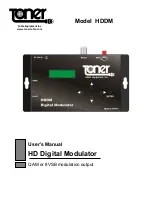
WP 34S Owner‘s Manual
Edition 2.2
Page 91 of 103
VIEW. This will produce the
αVW+ nn command. It is meant to display alpha together
with ('+') numeric data coming from any register. As with VIEW, X is allowed here. The
above comments regarding PSE or STOP following any of these commands are valid
here, too.
Another way to display the alpha register is to switch to alpha mode with
αON. The main
difference is that you are presented the tail of the string instead of its head. Also, a PSE
is necessary to update the actual display which
αON alone does not do. If followed by a
STOP, alpha mode stays on causing user input to go to the upper display!
αOFF returns
everything to normal.
Temporary Displays
Whenever the display does not show the actual contents of the X register in the current
mode, this is considered a temporary display. To distinguish this from the normal dis-
play, the RPN annunciator is off during temporary displays and on otherwise. The follow-
ing displays are considered temporary:
1. Any errors,
2.
αVIEW,
3.
αVW+
nn
,
4. VIEW
nn
where
nn
is not X,
5. VIEW X if encountered in a program because X may have changed before the
stop,
6. H.MS display,
7. Temporary display in another base (not programmable).
Press
or
to get back to the normal display.
Data Input
The easiest way of getting user input, apart from expecting everything on the stack, is
just stopping the program with STOP, letting the user input a number and let him press
to continue execution. Without any clue what the program is asking for, this is only
suitable for very simple programs. The least you want to do is present a message to the
user what he is supposed to enter when the program stops. This can be done with any
of the [alpha]VIEW commands followed by STOP. There is a shorthand especially made
for this: PROMPT. It is a combination of [alpha]VW+ X and STOP. It displays the alpha
register together with the current X register and halts program execution. This is good
for entering a lengthy list of parameters in a given order without much programming.
Hotkeys
A more versatile way of doing things is using the dedicated keys A to D in the top row. If
the user presses one of these keys the program executes the next subroutine or pro-
gram with a label of the same name. If you have more than one program using labels A
to D in RAM or in a flash region, it's necessary to move the program counter (PC) to the
top of the program and stop there. A typical program structure might be the following:









































